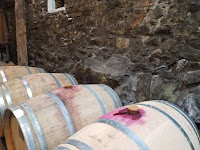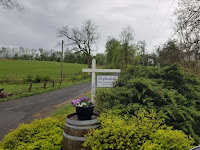 This weekend, Pentecost and Memorial Day landed on the same weekend and that served as an impetus to tour the historic St. Mary of Sorrows church and then, after mass at the new church, visit Bunnyman Brewing -- #thecompasscbf 2023 stop number 73.
This weekend, Pentecost and Memorial Day landed on the same weekend and that served as an impetus to tour the historic St. Mary of Sorrows church and then, after mass at the new church, visit Bunnyman Brewing -- #thecompasscbf 2023 stop number 73. St. Mary of Sorrows was the second Catholic church built in Fairfax County (behind St. Mary’s in Alexandria) after Irish immigrants moved to the area while building the Orange and Alexandria Railroad to what is now Fairfax Station. The names of these families can still be read on the tombstones standing in St. Mary's cemetery. The church was finished in 1860 just when the Civil War started brewing. "Given the church’s important location on the main road from Fairfax Courthouse to the depot of the Orange and Alexandria Railroad (now Fairfax Station), the area, with St. Mary’s as an identifying point, quickly became an important objective for both Northern and Southern armies vying to dominate the railroads in the area".
St. Mary of Sorrows was the second Catholic church built in Fairfax County (behind St. Mary’s in Alexandria) after Irish immigrants moved to the area while building the Orange and Alexandria Railroad to what is now Fairfax Station. The names of these families can still be read on the tombstones standing in St. Mary's cemetery. The church was finished in 1860 just when the Civil War started brewing. "Given the church’s important location on the main road from Fairfax Courthouse to the depot of the Orange and Alexandria Railroad (now Fairfax Station), the area, with St. Mary’s as an identifying point, quickly became an important objective for both Northern and Southern armies vying to dominate the railroads in the area". When Pope's Union army was flanked and routed by Longstreet and Jackson at the Second Battle of Bull Run or Battle of Second Manassas, a field hospital was moved to St. Mary’s. "The wounded were laid out on the Church’s hill, many on pews taken from the church. They awaited the unloading of food and ammunition from the trains in the railroad yard nearby, so they could be placed on trains going east to Alexandria.
When Pope's Union army was flanked and routed by Longstreet and Jackson at the Second Battle of Bull Run or Battle of Second Manassas, a field hospital was moved to St. Mary’s. "The wounded were laid out on the Church’s hill, many on pews taken from the church. They awaited the unloading of food and ammunition from the trains in the railroad yard nearby, so they could be placed on trains going east to Alexandria. Clara Barton had arrived from Alexandria on one of these trains. She was a clerk at the Government Patent Office who had gathered a group of volunteers to tend to the wounded and dying. She nursed the wounded for three days and nights as heavy rains fell and doctors operated in the only dry place available, the church. Many soldiers died and were buried in the churchyard. Although 20,000 Confederate soldiers began the push toward Fairfax Station, Miss Barton, her volunteers, and the doctors remained until the last of the wounded were evacuated. She watched from the windows of the last train as the Confederate Soldiers captured Fairfax Station and set fire to the depot. As a result of her experiences at Fairfax Station, she devised a plan to establish a civilian society, which became the American Red Cross. A plaque honoring her heroism sits on the Route 123 side of the church grounds".
Clara Barton had arrived from Alexandria on one of these trains. She was a clerk at the Government Patent Office who had gathered a group of volunteers to tend to the wounded and dying. She nursed the wounded for three days and nights as heavy rains fell and doctors operated in the only dry place available, the church. Many soldiers died and were buried in the churchyard. Although 20,000 Confederate soldiers began the push toward Fairfax Station, Miss Barton, her volunteers, and the doctors remained until the last of the wounded were evacuated. She watched from the windows of the last train as the Confederate Soldiers captured Fairfax Station and set fire to the depot. As a result of her experiences at Fairfax Station, she devised a plan to establish a civilian society, which became the American Red Cross. A plaque honoring her heroism sits on the Route 123 side of the church grounds"..
 Since the "original wood pews were destroyed during the Civil War, as mentioned above. Tradition holds that the present seats were installed at the order of President U.S. Grant. He often traveled by train to a resort in nearby Clifton, and ordered restitution when he learned of the damage inflicted on the church by Union troops...The soldiers buried in the churchyard during the Civil War were later moved to Arlington National Cemetery, with the exception of one Confederate named Kidwell. Only those bodies that could be positively identified were moved. Kidwell’s relatives wanted him to remain on Catholic ground, so they contrived a ruse with the pastor to not mark Kidwell’s grave so that his body would not be moved". (1)
Since the "original wood pews were destroyed during the Civil War, as mentioned above. Tradition holds that the present seats were installed at the order of President U.S. Grant. He often traveled by train to a resort in nearby Clifton, and ordered restitution when he learned of the damage inflicted on the church by Union troops...The soldiers buried in the churchyard during the Civil War were later moved to Arlington National Cemetery, with the exception of one Confederate named Kidwell. Only those bodies that could be positively identified were moved. Kidwell’s relatives wanted him to remain on Catholic ground, so they contrived a ruse with the pastor to not mark Kidwell’s grave so that his body would not be moved". (1) A beautiful new church for the expanding parish was constructed during 2019-2020 and is a stop on the A Jubilee Journey with Mary tour of Marian-Named Parishes in the Arlington Diocese.
 After attending mass or just visiting the new or old churches, Bunnyman Brewing is only minutes away. The brewery is named after a local Fairfax urban legend and provides abundant beer for those willing to risk encountering the hacket-throwing insane man dressed in a white bunny suit. These beers are dispensed using a self-serve system where visitors can pour the volume of their choice and are charged for that amount. I poured two flights of various levels in order to taste a broad representation of their portfolio. A full taster pour of Kölsch revealed a refreshing bready beer and I'm becoming a fan of the steady and easy-drinking English Mild Brown Ale. The biggest surprise was the Juicy Viking IPA brewed with Norwegian Kveik yeast and Ekuanot & Galena hops. A pint pour next time. And my favorite with a mini-taster at 12.5% was the Blinders Barrel-Aged S'mores Milk Stout. Delicious.
After attending mass or just visiting the new or old churches, Bunnyman Brewing is only minutes away. The brewery is named after a local Fairfax urban legend and provides abundant beer for those willing to risk encountering the hacket-throwing insane man dressed in a white bunny suit. These beers are dispensed using a self-serve system where visitors can pour the volume of their choice and are charged for that amount. I poured two flights of various levels in order to taste a broad representation of their portfolio. A full taster pour of Kölsch revealed a refreshing bready beer and I'm becoming a fan of the steady and easy-drinking English Mild Brown Ale. The biggest surprise was the Juicy Viking IPA brewed with Norwegian Kveik yeast and Ekuanot & Galena hops. A pint pour next time. And my favorite with a mini-taster at 12.5% was the Blinders Barrel-Aged S'mores Milk Stout. Delicious. 
















